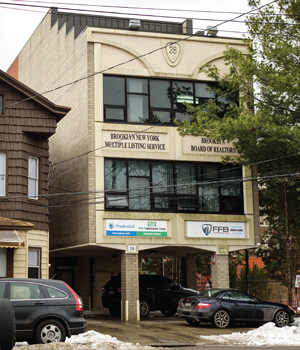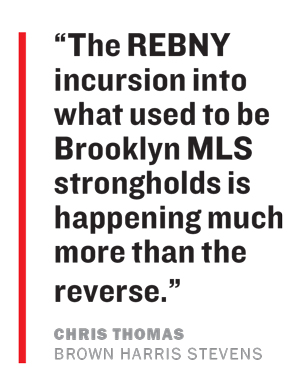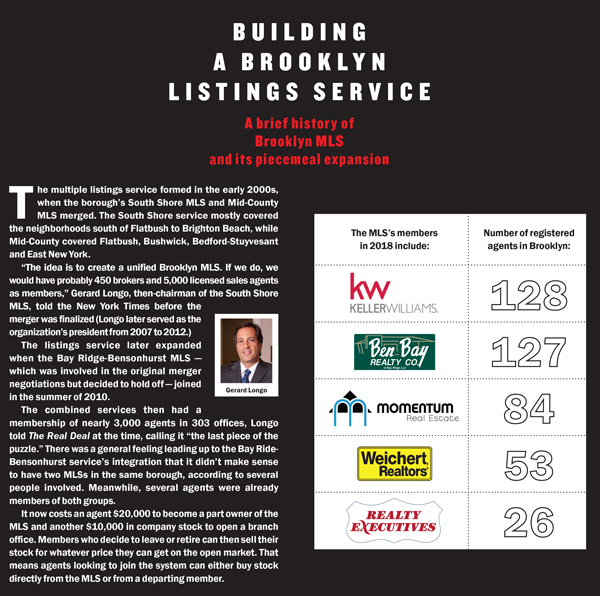Over footage of the Brooklyn Bridge, Coney Island and smiling couples standing in front of their homes, Brooklyn MLS boasts that it’s “some 4,000 brokers and agents strong” and “works tirelessly to assure that sellers, buyers and real estate agents always have the most accurate, relevant data at their fingertips.”
The online and television commercial, along with several bus ads, is a part of the company’s goal to make its listings service as well-known as its home borough.
Indeed, the MLS — which mostly covers the eastern and southern parts of Brooklyn — has rapidly expanded its reach. While its listings of single-family houses and apartments have held steady at about 4,000 over the past five years, its membership has jumped more than 50 percent, from 2,700 to 4,100 in the same period.
Moreover, it achieved these numbers without relying on the Real Estate Board of New York, the city’s largest real estate trade group, or the National Association of Realtors, which it ended its membership with roughly five years ago. And most of the city’s largest brokerage firms, including the Corcoran Group, Halstead Property and Citi Habitats, are absent from Brooklyn MLS’s membership.
Barbara LaBarca, a lifelong Brooklyn resident who started her real estate career in the early 1980s and took over as the MLS’s president for a second time in May, said she and her cohorts are happy to remain independent from groups like REBNY and NAR. The five-person team has no plans to hitch its wagon to a larger organization, she explained.
“It’s been good that we’ve been independent,” LaBarca, who also works as a registered Coldwell Banker broker, said in her thick Brooklyn accent. “We’ve been growing.”
Brooklyn MLS’s CEO, Richard Schulhoff, gives much of the credit for the organization’s growth to its recent advertising push. “Nothing works like advertising in this country,” he said.
Schulhoff formerly worked in sports entertainment, where he was head writer on ABC’s famed “Wide World of Sports” program from 1981 to 1985 and won an Emmy in 1992 for a live broadcast of the Breeders’ Cup he did for NBC Sports. Schulhoff’s first foray into real estate was in 2001, when he took over communications at the Staten Island Board of Realtors. He became the MLS’s first CEO four years later.

The Brooklyn listings service office in Gravesend.
“We’re doing amazing amounts of advertising, and it pays off,” said Schulhoff, a Queens native who has lived on Staten Island since 1979. “The television one, I think, caught people’s eye. It was done very professionally, and we didn’t scrimp on the amount of money we spent. Word of mouth gets around.”
But whether Brooklyn MLS can continue to grow rapidly without support from major lobbying groups and without roping in some of the city’s largest brokerages remains to be seen. And as the ongoing wave of gentrification in Brooklyn spreads to the borough’s more suburban neighborhoods, the listings service is facing more competition in some of its prime markets.
“First-time buyers are being priced out and moving deeper into Brooklyn, and REBNY firms are therefore getting listings there and extending their reach,” said Chris Thomas, managing director of sales at Brown Harris Stevens’ Brooklyn Heights office. “I would say the REBNY incursion into what used to be Brooklyn MLS strongholds is happening much more than the reverse.”
Deep in Brooklyn
Perhaps not surprisingly, Brooklyn MLS’s headquarters is nowhere to be found in its advertising campaign. The office lies tucked away on the top floor of a three-story tan brick building deep within Gravesend, and on a thoroughfare that some recent Brooklyn transplants may have never heard of: Village Road.
On the inside, the office is equally unassuming — a row of desks on a blue carpeted floor with some small decorations scattered throughout, including Superman floor mats and a small stuffed monkey wearing a black Zorro mask.
The firm shares space in the building with Prudential Financial and First Fidelity Brokerage. And the only indication of the borough’s hipster takeover is across the street, where a mural featuring Vincent van Gogh and a knockoff of the Beatles’ “Abbey Road” cover takes up a large amount of space on a brick wall.
Given the amount of attention that trendy areas such as Williamsburg and Dumbo receive in the press and public imagination, it’s easy to forget how much of Brooklyn is comprised of neighborhoods that don’t have the same cachet as those just a stone’s throw away from Manhattan. But the borough’s more far-flung pockets — Brighton Beach, Marine Park, Bensonhurst and Sheepshead Bay, to name a few — are exactly where Brooklyn MLS thrives.
Having agents in those areas is also something that its leadership prides itself on. Schulhoff said that the MLS’s membership mimics the diversity of Brooklyn itself, noting that there are large contingents of Asian, Russian, Jewish and Italian members, with the number of Russian and Asian members on the rise in recent years.
Lawrence Wong, a broker with Weichert Realtors – The Franzese Group who focuses on neighborhoods like Bay Ridge and Gravesend, noted that more Asians have started to buy homes in the southern parts of Brooklyn. “The demographics are changing,” he said, “and they’re comfortable working with their own people.”
 Based on the map of listings on the MLS’s website, which does not include agents’ exclusives, it has yet to establish a heavy presence in some of Brooklyn’s hipster havens. As of late January, it had the highest number of listings — 229 — in the Bay Ridge and Bensonhurst area, followed by 196 in Gravesend and Bath Beach and 182 in Midwood and Sheepshead Bay. Its numbers in the borough’s trendier areas were much smaller: 13 in Williamsburg and Greenpoint, 26 in Brooklyn Heights and Boerum Hill and 26 in Bushwick.
Based on the map of listings on the MLS’s website, which does not include agents’ exclusives, it has yet to establish a heavy presence in some of Brooklyn’s hipster havens. As of late January, it had the highest number of listings — 229 — in the Bay Ridge and Bensonhurst area, followed by 196 in Gravesend and Bath Beach and 182 in Midwood and Sheepshead Bay. Its numbers in the borough’s trendier areas were much smaller: 13 in Williamsburg and Greenpoint, 26 in Brooklyn Heights and Boerum Hill and 26 in Bushwick.
“It is like two different camps in Brooklyn,” said Charles Olson, the owner of Brooklyn-based Keller Williams Realty Empire and a member of both Brooklyn MLS and REBNY. “There’s the Brooklyn MLS world, and then you have the REBNY country — what I call the Manhattan part of Brooklyn.”
REBNY, which has more than 2,000 listings in Brooklyn, has a much stronger presence in the neighborhoods closer to Manhattan, with 267 properties in Williamsburg and Greenpoint, 108 in Brooklyn Heights and Boerum Hill and 68 in Bushwick, as of late January.
But whether Brooklyn MLS is making inroads in the borough’s more rapidly gentrifying or ritzier areas largely depends on whom you ask.
Gerard Longo, the principal of Brooklyn brokerage Madison Estates who served as the listings service’s president from 2007 to 2012, called the notion that the MLS is only strong in deep Brooklyn outdated and more in line with what its predecessor services offered in the early 1990s (see sidebar). He acknowledged that Brooklyn MLS remains stronger in some neighborhoods than others, but said the company is now well represented throughout the borough.
“I don’t think that stands anymore,” said Longo. “I think that you’ll see all of the members of Brooklyn MLS serving all of Brooklyn. Certain pockets are definitely stronger than others, and certainly other areas are gaining traction.”
An industry divided
Despite that growth, most of the leading Manhattan firms that have expanded their Brooklyn footprints in recent years have decided not to join Brooklyn MLS.
Several of those brokerages have cited their REBNY memberships as the primary reason, noting that it would be too expensive for them to join both organizations, as The Real Deal previously reported. Douglas Elliman is one of the only exceptions to date.
An annual membership with Brooklyn MLS costs individual agents and brokers $180, LaBarca said, while REBNY membership dues for residential salespeople are $325 for the first year and $400 thereafter, per the trade group’s website. Olson, for one, said that while he signed up for both services, most agents don’t.
Still, there are a handful who prefer Brooklyn MLS. Wong of Weichert Realtors said it helps him get the best price for his sellers, as the exposure their properties get on the system can help create bidding wars. He added that he hopes to see the MLS’s growth continue since the system will become more useful as more people use it.
“It’s a good tool because, obviously, we can’t sell all the listings ourselves,” Wong said, “so we give everybody else an opportunity as well.”
Marilee Pettet, a Keller Williams broker who deals in Bay Ridge and Dyker Heights, had a more mixed assessment of the MLS. She complimented its ability to provide agents with good market reports and daily updates, but said its occasional outdated listings and photography standards can make it a harder sell for certain clients.
Pettet cited one instance where a member posted photographs of a house on 81st Street in Bay Ridge, two of which had pictures of children with Hello Kitty images superimposed over their faces — presumably to hide their identities. She called the pictures unprofessional and said she couldn’t send the listing to her customer because she was too embarrassed. (It should be noted, however, that the same problem occurs even with larger listings services.)
Pettet and Keller Williams’ Olson argued that tonier neighborhoods like Brooklyn Heights and Carroll Gardens, often referred to as “Brownstone Brooklyn,” are primarily REBNY territory, so agents who also want to do business there would benefit from belonging to both REBNY and Brooklyn MLS.
Longo also maintained that belonging to both groups could benefit an agent by giving them the opportunity to cover more ground and cast a wider net. “Geographically, if you’re looking to work all of Brooklyn, between the two of them, they handle all of Brooklyn,” he said.
Different strokes
Still, the lines in the sand are hard to ignore, according to several sources. Olson described REBNY and Brooklyn MLS as competitors, and multiple people in the brokerage business said there can be tension between agents on each side over issues like commission splits and co-brokering practices.
And since it’s illegal for any individual or organization to regulate commission splits, problems can arise when agents from the two groups work together.
 “Commission splits can’t be mandated,” Thomas of Brown Harris Stevens said, “but it does make for a chaotic process when a broker representing a buyer can never be sure how much commission, if any, is being offered by the exclusive agent.”
“Commission splits can’t be mandated,” Thomas of Brown Harris Stevens said, “but it does make for a chaotic process when a broker representing a buyer can never be sure how much commission, if any, is being offered by the exclusive agent.”
A REBNY spokesperson said only that the trade group has a friendly relationship with Brooklyn MLS and that the two organizations are not working on any joint initiatives for the time being.
Schulhoff and LaBarca said they have not considered partnering with REBNY because their structures are too different — Brooklyn MLS is a shareholder organization, while REBNY is not.
“We discuss things of mutual interest, but the subject of mergers never comes up from either one of us,” Schulhoff said. “It would be difficult to merge a shareholder organization into a non-shareholder organization.”
With Brooklyn MLS and the National Association of Realtors, there is even less communication. Schulhoff said his company decided to end its affiliation with NAR in 2012, after it gave a competing listings service realtor status. Doing so, Schulhoff said, violated a rule that the association could not give the status to an MLS in an area where one already existed.
“We told them that if those rules weren’t corrected within six months, we would become a realtor voluntary organization,” he said. “The rules were not corrected, and so our board of directors removed the bylaws from our system that said you had to be a [registered] realtor.”
An NAR spokesperson said the organization is not “familiar with the history of Brooklyn MLS and therefore cannot comment on it as an independent, broker-owned business that does not fall under NAR’s purview or within the scope of our policies.”
However, although Brooklyn MLS is not affiliated with NAR, it does have a close relationship with the Brooklyn Board of Realtors, a local chapter of NAR. As it happens, Schulhoff is also the CEO of that group, which is housed in the same building as the MLS. The Brooklyn Board of Realtors pays an administration fee to the MLS to run its day-to-day operations and transfers about 85 percent of the dues that it collects to the organization.
Informal lobbying
While Brooklyn MLS lacks the support of NAR — which has spent more than $30 million on lobbying every year since 2012, per the Center for Responsive Politics — Schulhoff said the breakup benefited the listings service in the long run by loosening its membership requirements.
At this point, he estimated that about 1,300 of his company’s 4,100 members are realtors. “I think we would have grown anyway,” he said. “But it made it simpler for people to join.”
Schulhoff said his team now occasionally works with the New York State Association of Realtors. The two groups are usually on the same page in terms of policy and political matters, he noted, so if an issue comes before the city or state that the MLS feels passionately about, it will generally throw its weight and support behind NYSAR. Representatives for NYSAR declined to comment.
Schulhoff added that formal lobbying efforts are less important for his organization, since its board of directors has a good rapport with the local politicians who represent those Brooklyn neighborhoods. “We basically have a good connection with several of the state senators in the area and all the congressmen and women,” he said.
One such politician is Martin Golden, the only Republican state senator from Brooklyn. In a statement, Golden described the leadership of the MLS as “strong and effective” and said he looks forward “to continuing to support their efforts to create a stronger and more attractive Brooklyn.”
Ken Fisher, a government relations and real estate attorney at the law firm Cozen O’Connor, said that it might make sense for Brooklyn MLS to take a more active lobbying role in the long term. But on a day-to-day basis, it makes more sense for the organization to take the back seat and “let the industry deal with it,” he noted.
Bigger fish to fry
Brooklyn MLS’s larger priority is attracting the big firms that have yet to opt in. Schulhoff said that although he and his team have tried to get firms like Corcoran and Citi Habitats to sign up for the MLS, they haven’t made much progress. One of the larger sticking points is the organization’s insistence that every Brooklyn office of the brokerages join the system, which has led to somewhat of a stalemate in negotiations.
“We’re still talking, but as of yet, unfortunately, we don’t have a compromise,” Schulhoff said, noting that the MLS has “too many members that have multiple offices, and it would not be fair” to make exceptions for other firms.
That issue is now coming to a head with Douglas Elliman, which wants to reduce the number of its offices that use the listings service. Schulhoff said he and the other board members plan on discussing the matter in their next meeting, on Feb. 14, but it’s unclear if the brokerage will continue its membership, which is paid for until July 1. A representative for Elliman declined to comment.
Halstead Property — which opened its first office in Brooklyn in 2004 — is one of the larger Manhattan brokerages that still hasn’t signed on with the MLS. Trish Martin, the firm’s managing director of sales in the borough, said that while Halstead does not like to shut the door on potential partnerships or collaborations, her team has not yet found a viable reason to join.
“We find that when we are representing buyers, we’re able to find the best and most qualified markets for those people, and we’ve never really had a need to affiliate with Brooklyn MLS,” she said, noting that Halstead’s REBNY membership gives her office an extended reach into the borough.
Martin added that Halstead and REBNY have a strong presence in some of the deeper Brooklyn neighborhoods like Bay Ridge. “We’ve pushed out further and further into Brooklyn,” she said. “The beauty of REBNY’s database is that it evolves as the business evolves. You’re not locked into a static environment.”
Renee Dorsa, a broker at Brooklyn’s Dorsa Group Realty, also noted that the dividing lines between Brooklyn MLS and REBNY are getting less stark as REBNY establishes a stronger foothold in southern Brooklyn. But rather than picking a side, she said she thinks this will spur the firms to work together more.
“If the two boards continue to work more universally in the areas where they’re both present, it will facilitate [their] agents being able to work with each other,” she said.

